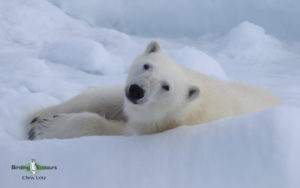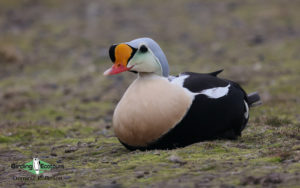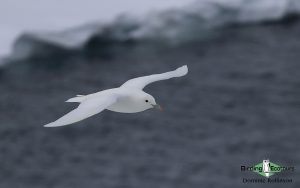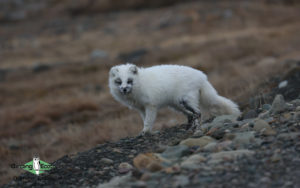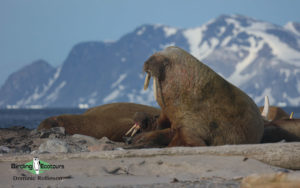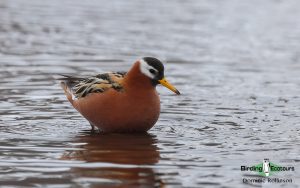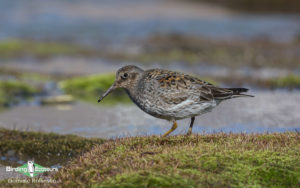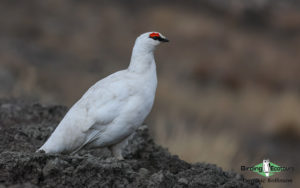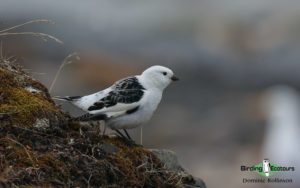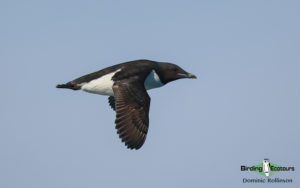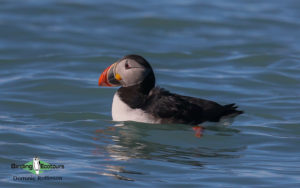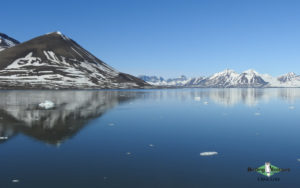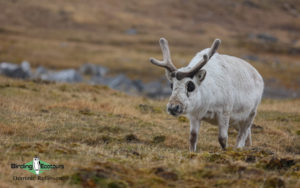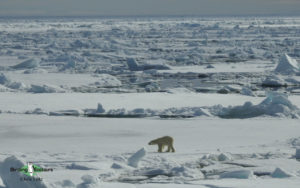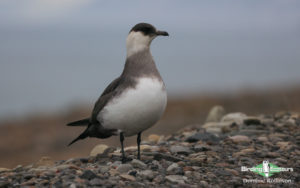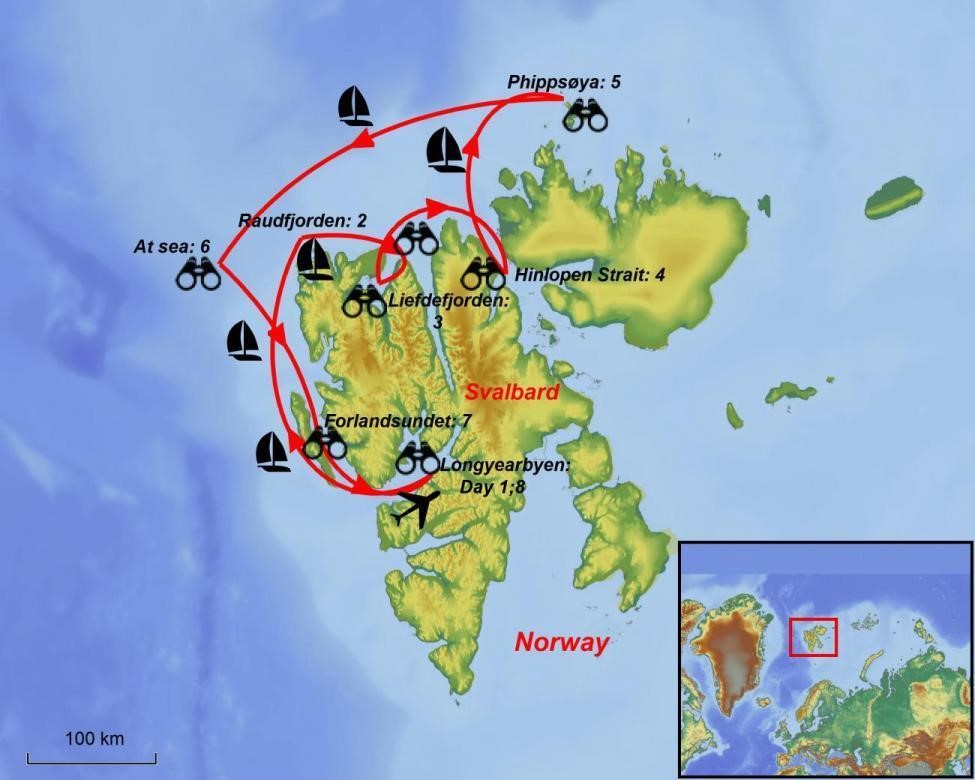Mammal and Birding Cruise Norway: Svalbard (Spitsbergen) — Polar Bears and Seabirds
Arctic Mammal and Birding Cruise Norway: Svalbard (Spitsbergen) — Polar Bears and Seabirds
June 2026
This Arctic birding and mammal cruise around Svalbard allows you a once-in-a-lifetime opportunity to be acquainted with special birds and mammals of the High Arctic. The list of likely species (both birds and mammals) is a rather short one, however it is quality over quantity here, as these specials are mostly only possible in the High Arctic. Another highly exciting element of Arctic birding is that you get to enjoy several widespread species in their fine breeding colors – a breeding plumaged Red Phalarope takes some beating! We invite you to join us on this exciting cruise as we explore the Svalbard Archipelago and enjoy finding some truly iconic Arctic wildlife.

You will arrive in the world’s northernmost town, historic Longyearbyen (previously known as “Long Year City”), deep within the Arctic Circle, and we will have time to explore this small city of about 2,000 human inhabitants. We usually spend some time birding around Longyearbyen, where several species are more easily observed (than on the cruise) and often make for good photographic subjects. We then depart on our cruise for the northern parts of the beautiful, remote Svalbard Archipelago (previously known as Spitsbergen).
While one of our main targets on the Arctic wildlife cruise will be Polar Bear (and other High Arctic mammals), our guide is first and foremost a birding guide, so we will be constantly watching for the Arctic’s special birds. Some of our bird targets include Ivory Gull in the pack ice in the far north, with Rock Ptarmigan often found on our landings, and we will also try for all the sea ducks and the many other desirables. The scenery in the ‘land of the midnight sun’ is truly spectacular, with the many glaciers, fjords, jagged peaks, and myriads of small islands constantly taking your breath away!
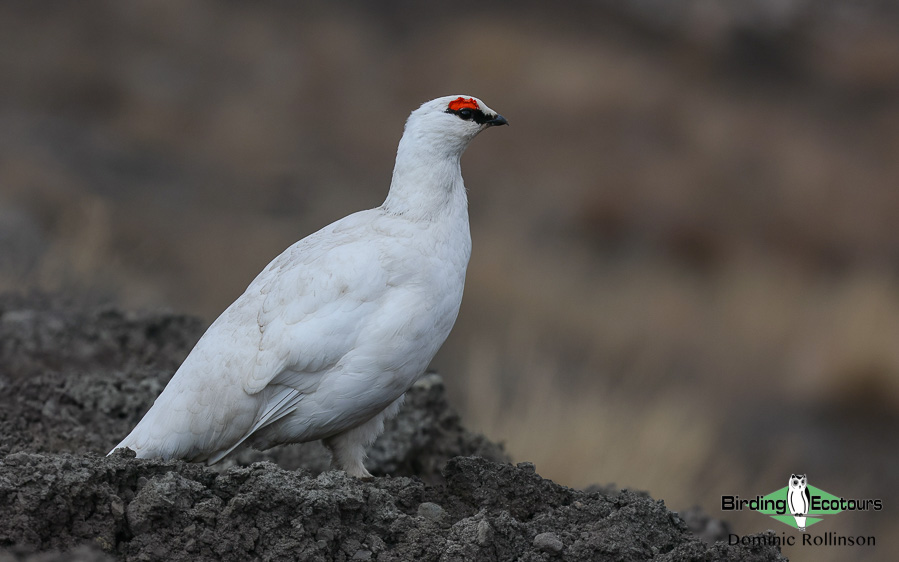
While on this eight-day Arctic cruise we will head up the northwest coast of the Svalbard Archipelago, although the final itinerary is based on sea ice and weather conditions. We will generally partake in a couple landings and/or zodiac cruises (in small inflatable boats) per day which ensures we can get closer to the wildlife and birds, and often results in many fantastic photographic opportunities.
Itinerary (8 days/7 nights)
Day 1. Birding Longyearbyen, then cruise ship departs
We suggest arriving in Longyearbyen, the capital of Svalbard, Norway, the world’s northernmost city, the day before the cruise departs, in case of any flight delays. Before the early evening departure (or the previous evening, if you arrive the day before our ship departs) we will explore this old mining town in search of Brant and Barnacle Geese, King and Common Eiders, Red and Red-necked Phalaropes, Common Ringed Plover, Glaucous Gull, Parasitic Jaeger, Rock Ptarmigan, Purple Sandpiper, Snow Bunting, and Arctic Fox which are often seen scavenging at the base of seabird cliffs. Although we should see most of the above on the actual Svalbard cruise, we often get better and more prolonged views, with improved photographic opportunities, on our Longyearbyen day tours. Please see the ‘Costs’ section to find out about additional costs for a Longyearbyen day tour prior to the cruise.
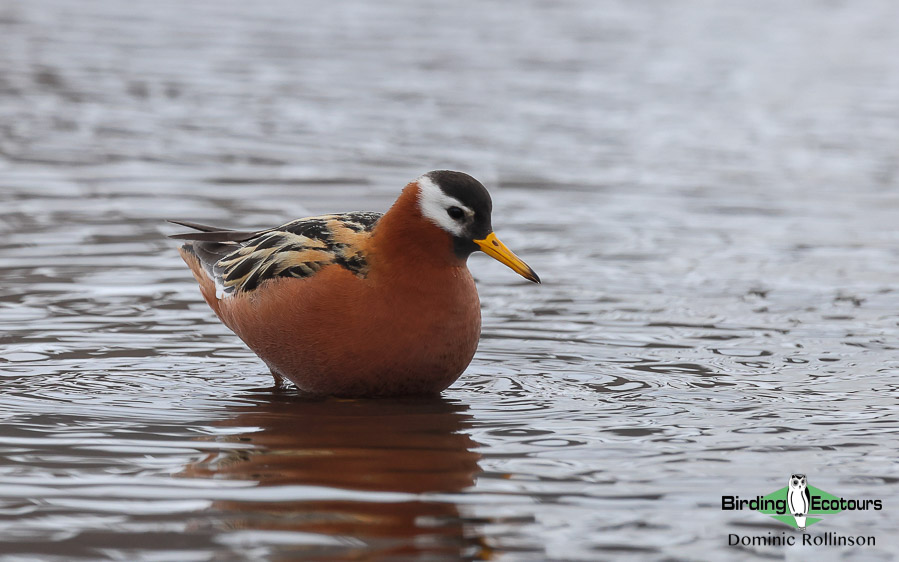
Upon setting sail out of Isfjorden, the second-longest fjord in the Svalbard Archipelago, we may see our first Northern Fulmar, Red-throated Loon, and Common Minke Whale, or perhaps we will get very lucky with an early sighting of the angelic Beluga Whale! Our voyage will be on board a 300–350-foot polar vessel which accommodates up to 170 passengers.
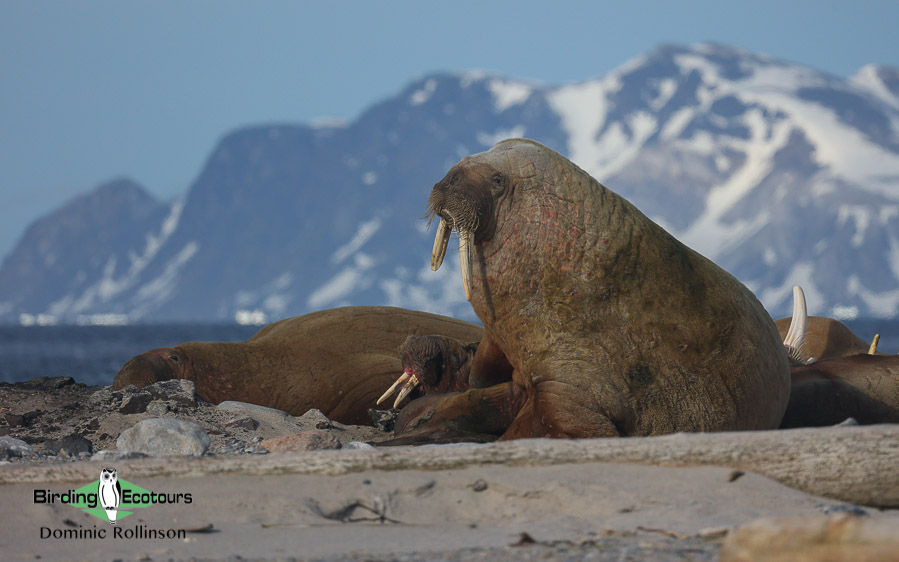
Days 2-7. Enjoying northwestern Spitsbergen’s natural beauty and wildlife
Over the next six days we will visit a variety of spectacularly beautiful fjords, seabird breeding colonies, and other fascinating landing sites. The final itinerary is entirely weather- and condition-dependent and will be decided by the expedition leader while on the cruise. Below are some of the exciting destinations and activities we might enjoy over the next few days.
Along the northern coast of west Svalbard we will cruise alongside beautiful glaciers while enjoying the area’s impressive wildlife. In this area of Svalbard, Polar Bear is sometimes seen, in addition to Bearded and Harbour Seals. The shoreline cliffs at 14 Julibukta are home to colonies of seabirds, including Thick-billed Murre (Brünnich’s Guillemot), Atlantic Puffin, and Black Guillemot. High up above, masses of Black-legged Kittiwakes breed, with Artic Foxes often prowling the lower slopes for fallen eggs and chicks. Lush vegetation flourishes in areas protected from the weather, and on our landing, we may find some of the Arctic’s flowering plants here.
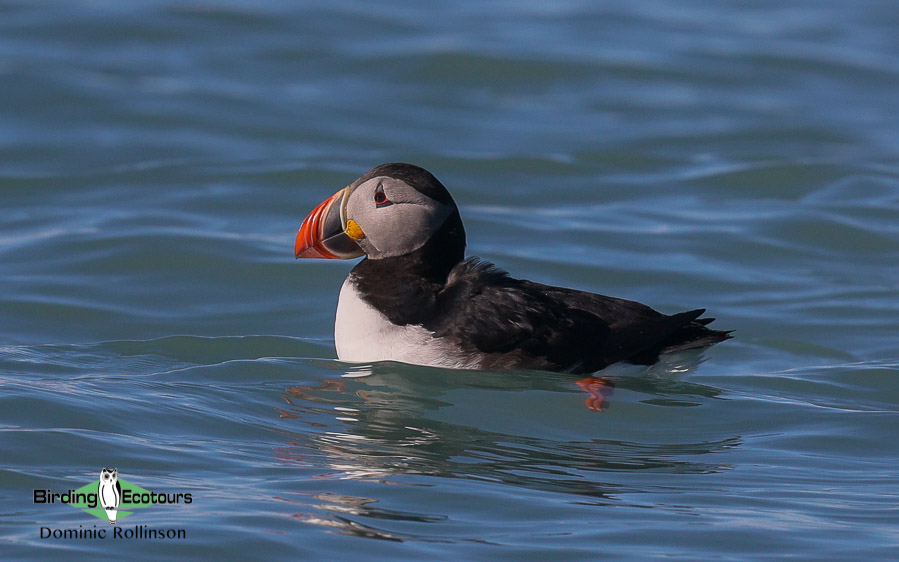
We hope to visit Krossfjorden which is close to Ny Ålesund, the most northerly settlement on Earth, once a mining town and now a research base. It was at Ny Ålesund that Amundsen and Nobile anchored their airships prior to their successful crossing of the North Pole. The area often has breeding Arctic Terns around, as well as Great Skuas, and Red-throated Loons. While cruising Krossfjorden it is always keeping an eye out for attractive Long-tailed Jaegers, as some of the archipelago’s few known breeding pairs are found nearby. Common Eiders occur along the coastline here and these attractive sea ducks are likely to feature on most days of the cruise.
Weather dependent, we will sail along the three-mile-long face of Monaco Glacier, heading into Liefdefjorden. These waters harbor a favorite food source for Black-legged Kittiwake, offering spectacular views of thousands of birds. Polar Bear also frequents the glacier, sometimes providing good photo opportunities. The rare Sabine’s Gull will also be on our radar in this area as we will be relatively close to one of their breeding islands at Moffen Island.
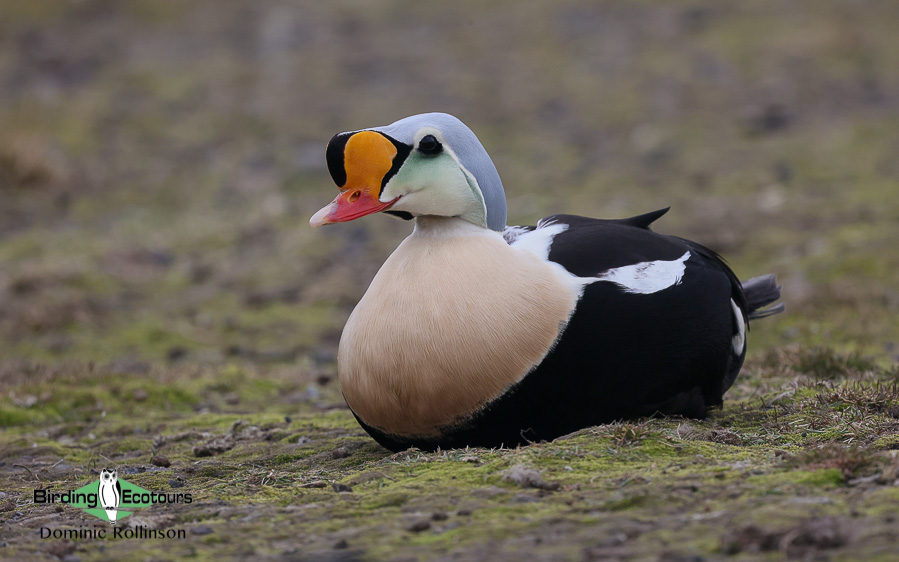
Seven Islands will likely be the most northerly point we visit on this Arctic cruise. This area likely represents our best chance of finding our most important mammalian target, Polar Bear, and we will ensure we have our scopes out on deck scanning for bears. The pack ice is also the best area to find our most important avian target, this being Ivory Gull, which is a delight to observe. There are usually good numbers of alcids around in this area too, with Black Guillemot, Thick-billed Murre, and Little Auk constantly giving flyby views. There will hopefully also be good numbers of seals on the pack ice in the north, with Bearded, Harp, and Ringed Seals being the most likely candidates.
We will likely also stop in at Sorgfjord where we visit a haul-out of massive Walruses and enjoy a walk in the Arctic tundra which often produces Rock Ptarmigan and shorebirds, such as Purple Sandpiper, Ruddy Turnstone, Dunlin, or Sanderling – all looking dapper in their breeding colors.
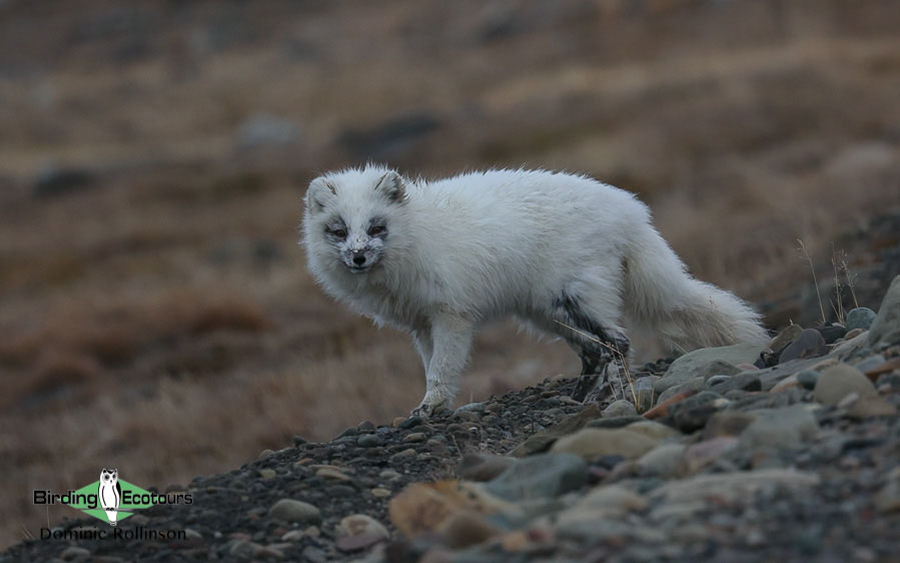
Navigating through the Hinlopen Strait will prove to be rich in Arctic wildlife. We will have opportunities to see thousands of Thick-billed Murres alongside some impressive Arctic wildlife such as Polar Bear, Ringed and Bearded Seals, and if we are lucky Blue Whale – the largest animal known to have ever existed. In our zodiacs we may cruise through the sea ice floes of Lomfjordshalvøya and visit a huge colony of Thick-billed Murres at the cliffs of Alkefjellet. We will also attempt to land at Torrelneset on the island of Nordaustlandet, where Pink-footed Goose, (Svalbard) Reindeer (the smallest subspecies of Reindeer), and Walrus may be seen. As we cruise through the Hinlopen Strait we will pass through the foraging waters of Fin Whales and have decent chances of spotting Common Minke Whale.
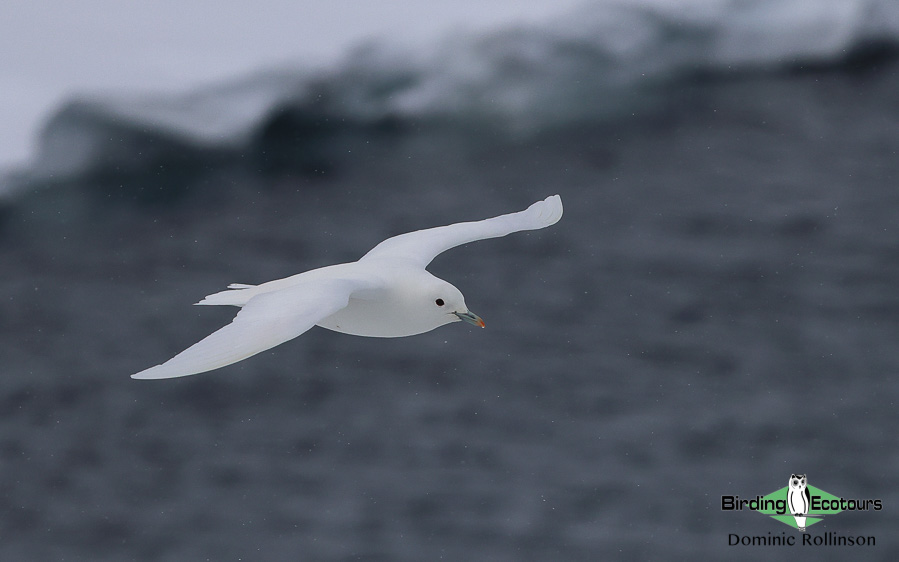
Weather dependent, we will either sail into Forlandsundet, where we might encounter Walrus, or alternatively into St. Johns Fjord or to Isfjorden and possibly landing on Alkhornet, where along the cliffs we will look for nesting seabirds and along the base of the cliffs Arctic Fox may be seen foraging for fallen chicks or eggs. We may see Svalbard Reindeer grazing before making a nighttime arrival back in Longyearbyen.
Day 8. Disembarkation at Longyearbyen
We will come ashore in Longyearbyen on this last day of our journey for flights south to Oslo and from there to our home destinations.
PLEASE NOTE: A typical itinerary to the northern Svalbard Archipelago is illustrated above. This itinerary is for guidance only. Depending on local ice and weather conditions, the availability of landing sites, and opportunities to see wildlife, the program may vary. The expedition leader on board will determine the final itinerary. Flexibility is paramount for expedition cruises. Average cruising speed for the vessel is 10.5 knots.
Download ItinerarySvalbard: Arctic Birding and Wildlife Cruise Trip Report
31st MAY – 8th JUNE 2023
By Dominic Rollinson
DOWNLOAD TRIP REPORT
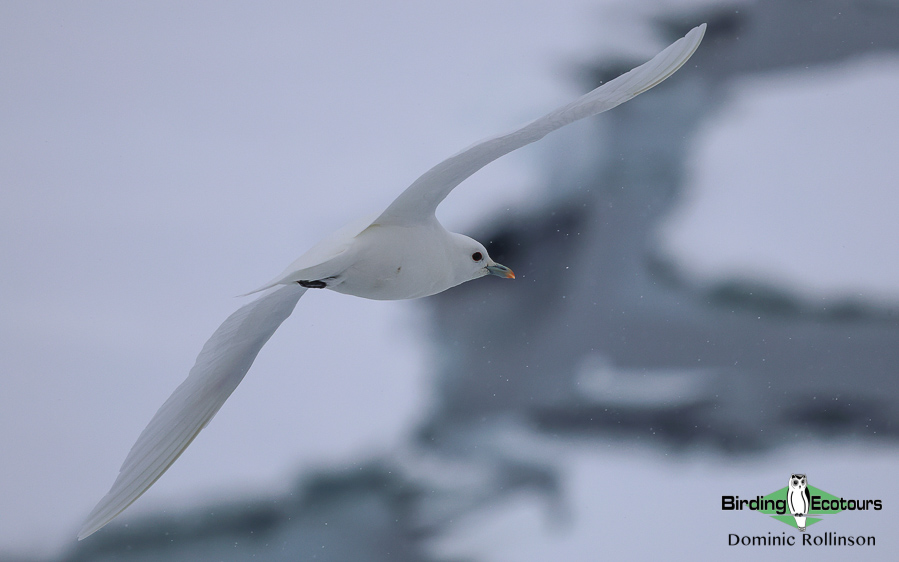
Overview
Arctic birding and wildlife cruises offer the rare chance to explore a world that so few people ever get to experience. On these cruises we search for a small group of high Arctic bird and mammal species which can tolerate the harsh conditions of life in the Arctic Circle. Most people have likely heard of the large charismatic megafauna which occur in the Arctic such as Polar Bear, Walrus and Arctic Fox, and these are of course targeted (and usually found) on these cruises. However, there is also a suite of lesser-known birds and mammals which we look for too, such as Ivory Gull, King Eider, and Bearded Seal.
Just about all Arctic wildlife cruises depart from the town of Longyearbyen (hailed as the world’s most northerly settlement, with a population over 1,000 people) on Svalbard Archipelago’s largest island of Spitsbergen. Before the cruise departs, we usually do a morning or afternoon (or both) around town, where we can often get closer views of Red Phalarope, Red-throated Loon, King Eider, Rock Ptarmigan and Arctic Fox – which we normally see on our cruises but which tend to keep their distance. This trip was no different and we got excellent views of all our Longyearbyen targets, and got introduced to some of the area’s more common and widespread wildlife.

Of course, a cruise to the Arctic is generally focused on finding Polar Bear, the King of the Arctic, and although most cruises are successful, sightings are not guaranteed. Thankfully, on this year’s Arctic cruise we had good sightings of a single bear while up in the pack ice. Although our sighting was perhaps a little distant, we were able to watch it on and off for well over an hour and even watched it raising up onto its hind paws and crashing down with its front paws to try smash through the ice. With the aid of our spotting scope we could enjoy good extended views of this truly massive and charismatic predator.
While up in the pack ice in the northwest of the Svalbard Archipelago we had fantastic repeat views of Ivory Gull, which is probably the most-wanted bird special on an Arctic wildlife cruise. While we were watching the Polar Bear, we even had a small group of Ivory Gulls come and land on the ice near our ship, further adding to the special moment. Other memorable sightings included great looks at Walrus (complete with an Ivory Gull on an ice floe), a small group of huge Blue Whales which showed really close to the ship for about an hour, and a few unexpected avian bonuses such as Iceland Gull, Tufted Duck and, most surprisingly, a very lost Western Yellow Wagtail – one just never knows what one might bump into!
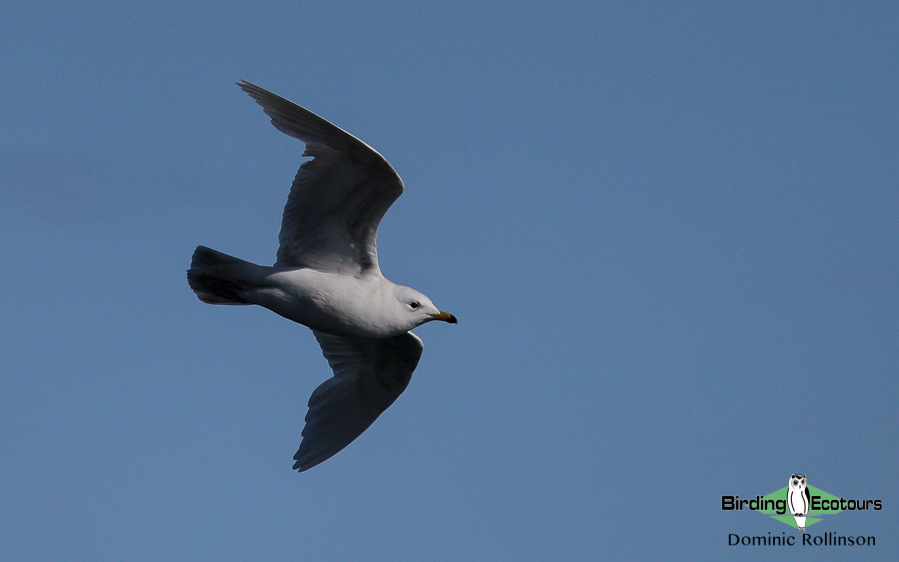
Weather in the Arctic can be a little unpredictable at times, however we were exceptionally lucky this time around, with perfect weather for just about every single day of the trip. On most days the sun was out and shining, which further aided photography in the land of the midnight sun. We had many perfectly still evenings, with glorious golden light which added to the enjoyment of the trip.
Detailed Report
Day 1, 31st May 2023. Arrival and Longyearbyen birding
Our Scandinavia Airlines flight landed around midday and headed into Longyearbyen, the most northerly town in the world. After checking in to our accommodation, we were soon back out the door and took a drive around town and some other nearby birding areas. Our first stop was at the husky kennels just east of town, where we enjoyed the large numbers of Common Eider, which are kept safe here because the huskies ensure Arctic Foxes are kept out of the area. We then made our way further east of town where we found Barnacle, Brant and Pink-footed Geese, and struck gold when we found an obliging female (females being the better looking of the sexes in phalaropes) Red Phalarope which was in fine breeding dress and did not seem at all perturbed by our presence. A nearby lake had a pair of Red-throated Loon as well as three Red-necked Phalarope, which are not quite as good-looking as Red Phalaropes, but nevertheless are very attractive species in their breeding colors. There were good numbers of Purple Sandpipers around too, with their high-pitched display call being a sound we would hear regularly over the next week.
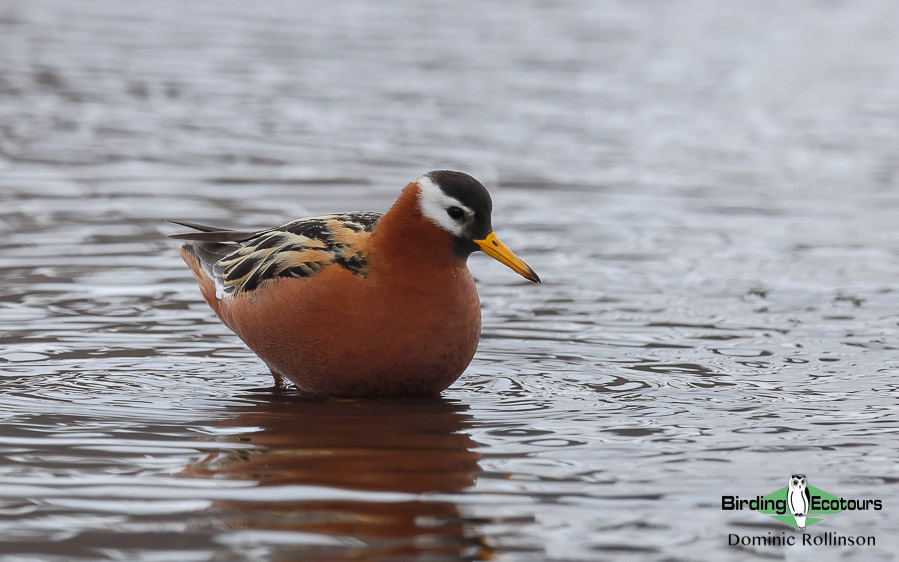
The ponds below the airport produced a fantastic pair of King Eider, in amongst the many Common Eider. Further west of the airport, the cliffs were alive with singing Little Auks (Dovekies), and many Thick-billed Murres (Brünnich’s Guillemot), Northern Fulmars, Black-legged Kittiwakes and Glaucous Gulls seen flying out over the fjord. This area is normally a reliable site for feeding Arctic Foxes, but unfortunately there were none around this afternoon. We ended the day with burgers and beer in town, and excitedly discussed our Arctic birding and wildlife cruise which was to begin the following afternoon.
Day 2, 1st June 2023. Birding around Longyearbyen and boarding the Plancius
We were to board the Plancius late in the afternoon and therefore had most of the day to further enjoy the birding and wildlife around Longyearbyen. We began the day working some areas just above town frequented by Rock Ptarmigan, and it did not take long before a beautiful snow-white male performed its display flight above our heads. With this cruise taking place early in summer, it meant that many of the males were still in their immaculate white plumage and were a pleasure to observe. In this area we also watched a pair of Common Ringed Plovers which were in beautiful crisp breeding plumage and did not seem at all worried by our presence.
Heading west of the airport again, we saw most of the same bird species as yesterday afternoon, including a first-summer male King Eider, which was interesting to see, but the real highlight was when Karen spotted an Arctic Fox with another three animals seen in the area. The foxes were no longer in their pure white winter coats, with large patches of grey appearing throughout and perhaps looking a little scruffy. Interestingly, two of the animals had satellite collars, which are used to monitor their movements. On the cruise we learnt that satellite-tagged Arctic Foxes had been crossing from Svalbard all the way to Greenland and Canada!
We stopped at the same pond (east of town) as yesterday afternoon, where the Red-throated Loons were again seen and, additionally, we found a male Tufted Duck (a scarce bird on Svalbard), as well as a fantastic pair of Long-tailed Ducks which flew in nearby and gave us really great views. A single female Red Phalarope was seen in the area too, but there was no sign of yesterday’s Red-necked Phalaropes. We ended our Longyearbyen birding with a walk down to the water’s edge, where we had close-up views of a pair of Parasitic Jaegers and our closest views of Brant Geese.
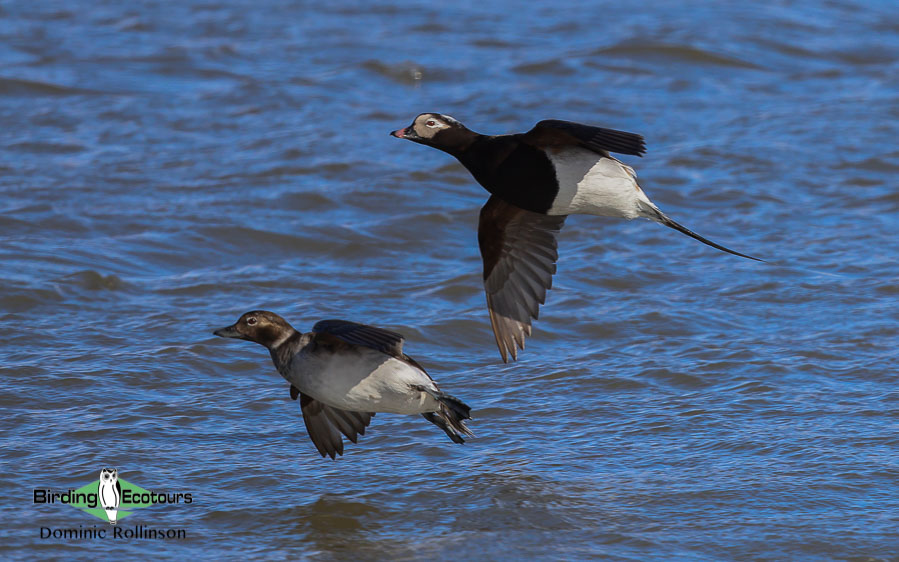
Later in the afternoon, after an enjoyable 24 hours around Longyearbyen, we boarded our vessel and slowly made our way out of Ysfjorden in gorgeous weather. We were escorted out by Northern Fulmar which seemed to be enjoying themselves as they whizzed by at eye level, giving us superb views.
Day 3, 2nd June 2023. Birds and other wildlife of St Jonsfjord and Poolepynten
The weather was beautiful this morning and had, in fact, improved further since the previous evening, with hardly a breath of wind around. After breakfast we boarded zodiac boats and headed off for our first landing of the trip, at St Jonsfjord. We took a walk around the general area (where an old trapper’s hut still exists) and enjoyed some splendid scenery and weather. We had good views of a small group of Reindeer– of the endemic Svalbard subspecies – which are shorter legged than other Reindeer subspecies. The air was full of the sounds of Snow Buntings and Purple Sandpiper, and we were fortunate enough to spot several distant Bearded Seals sitting on the fast ice at the base of a glacier. We lifted anchor and en route to our next location we noticed some huge footprints on the mountainside, which could have only been made by one animal. Sadly, despite some concerted scanning with the telescope, we did not find any Polar Bears!
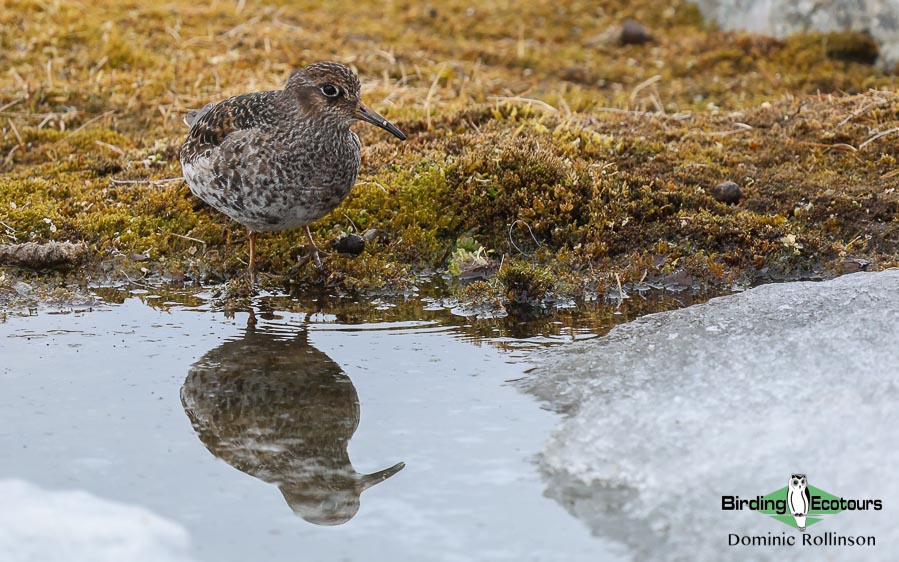
The afternoon’s activity involved a visit to the pebble and sand beach at Poolepynten, where we observed an impressive Walrus haul-out. This area is a reliable place to observe these gigantic tusked seals, with all the animals seen here being males, as the females were away giving birth to their pups on floating ice. The setting was spectacular, with the Walruses in the foreground and ice-capped mountains in the background, with a sailboat passing by to add to the scene. While we were watching the large lump of Walruses, we noticed a gull that looked different from the many Glaucous Gulls around and quickly realized it was an Iceland Gull, which is a scarce bird in the Svalbard Archipelago and an unexpected bonus for the afternoon. Our walk back along the beach added another new trip bird in the form of a Ruddy Turnstone, which flew by noisily.
Later that evening, as most of the passengers were getting ready for bed, the announcement came over the speaker system that there were whale blows off the bow. We all quickly got back into our outdoor clothes and enjoyed the spectacle from the bow. At least six Blue Whales were seen at varying distances, with a couple animals showing really close to the ship. Observing the largest animal to have ever lived was a perfect way to end the day!
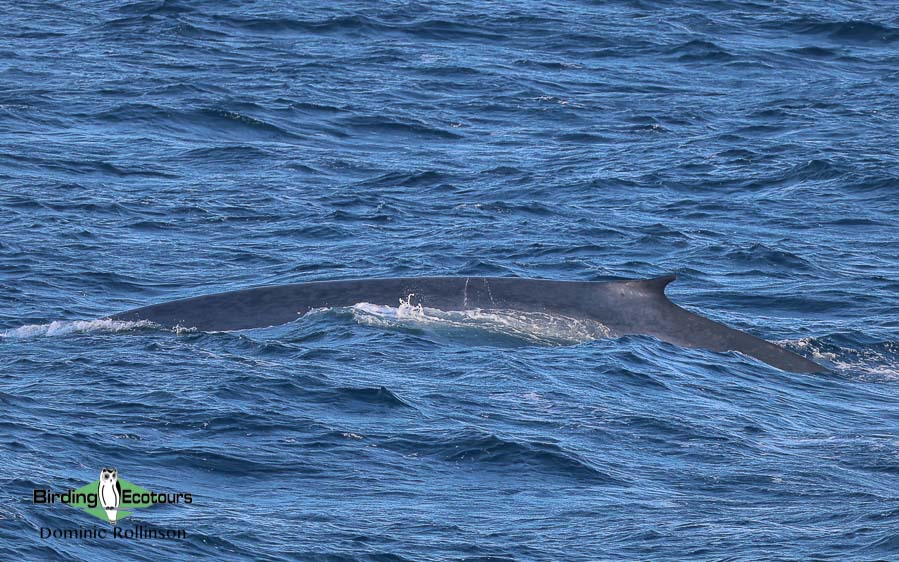
Day 4, 3rd June 2023. 14 Julibukta and Lillehookbreen
We awoke to another beautiful morning in the Arctic and found ourselves in the beautiful 14 Julibukta (bukta being Norwegian for bay), with another impressive glacier on display nearby. After breakfast we set out on a zodiac cruise and enjoyed close views of the massive glacier, with large numbers of photogenic Black-legged Kittiwakes sitting on the ice floes. We then made our way towards the seabird cliffs, marveled at the masses of breeding kittiwakes overhead and enjoyed closer views of breeding Thick-billed Murres, Black Guillemots and our first Atlantic Puffins of the trip. It was then our turn to land at the stony beach, and we enjoyed walking slowly below the kittiwake cliffs (high up above) and were lucky enough to have close views of two Arctic Foxes (including one of the scarce dark-morph animals) which were busy searching for fallen eggs. We also had lovely views of a confiding Purple Sandpiper and brief views of several Snow Buntings.
In the afternoon we had a prolonged zodiac cruise of Lillehookbreen (breen is Norwegian for glacier) and marveled at the magnitude of the glacier which we cruised nearby to (but not too close to). There were good numbers of waterfowl seen amongst the ice floes, including dozens of King and Common Eiders and a small group of Long-tailed Ducks. A Red-throated Loon made a brief appearance as it flew by overhead. We enjoyed close views of Arctic Terns as they perched on floating ice, which made for some nice photographic opportunities. A Parasitic Jaeger was also seen perched on the ice, although this individual was not as accommodating as the terns!
Day 5, 4th June 2023. Into the pack ice and beyond 80o north!
Today was our first day navigating through the pack ice and we awoke to find the ship on the edge of the pack ice and soon after breakfast we crossed 80o north. The pack ice is generally the most reliable area to find Polar Bear and so we ensured we spent as much time as possible scanning with binoculars and telescopes for large cream-colored bears. Although today was not to be our day for bears, we almost immediately found our primary avian target, Ivory Gull, and we ended up finding 15 birds over the course of the day, with both adults and juveniles seen well. There was an obvious lack of large megafauna seen today (with only Harp Seal positively identified), however there were large numbers of birds around, including Black-legged Kittiwake (hunting for fish as we broke through the ice), Glaucous Gull, Thick-billed Murre, Black Guillemot, Little Auk, and surprisingly Ruddy Turnstone and Snow Bunting. Despite not seeing any Polar Bears today, it was a thoroughly enjoyable day in this unique environment that so few people ever experience. That evening we enjoyed a barbecue out on deck, which was good fun and a nice way to end our first day in the pack ice.
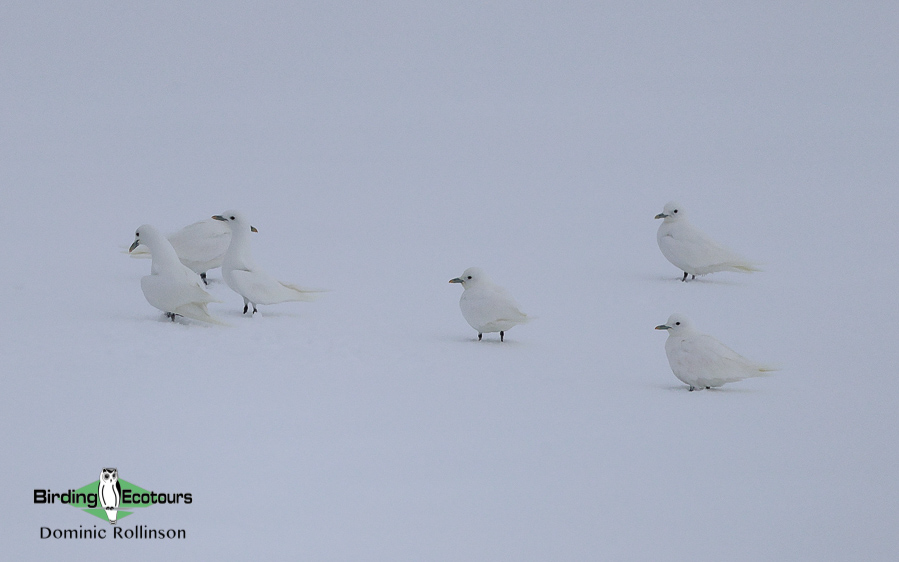
Day 6, 5th June 2023. More time in the pack ice
The day could not have got off to a better start when at around 06h30 the call came through on the speaker system that a Polar Bear had been spotted from the bridge and that we were slowly edging towards it. We all rushed outside and although the Polar Bear was some distance away, we eventually had good views as the ship was able to move relatively close to it. We enjoyed watching the bear, which seemed completely unfazed by the ship being nearby, and it even took a ten-minute nap. The bear then headed away from our vessel and kept getting further from us. We tried to get close views but it unfortunately chose an area where our ship was unable to access (due to thick pack ice) and so we decided to keep moving through the pack ice and see what else we could find. Another highlight while we enjoyed the bear, was a group of Ivory Gulls which perched on the ice right next to the vessel and showed very well for us.
Today proved much more productive than yesterday and we encountered large numbers of seals of a variety of species (likely the reason the bear was in the area). The large Bearded Seal showed well for us with some animals seen quite close to the vessel, where we could see their long whiskers, giving them quite a comical look. Harp Seals were seen regularly, mostly just brief views of swimming animals, until a fantastic male showed wonderfully well for us on an ice floe. Ringed Seals were also commonly encountered, however these animals were always at some distance away and were best enjoyed through the telescope. Unlike Harp and Bearded Seals, Ringed Seals were often seen well away from the ice edge as they tunnel holes through the ice, to escape from predatory Polar Bears. A Walrus posed for us on an ice floe in the late afternoon, complete with an Ivory Gull next to it to complete the picture – it really was a beautiful and peaceful scene!
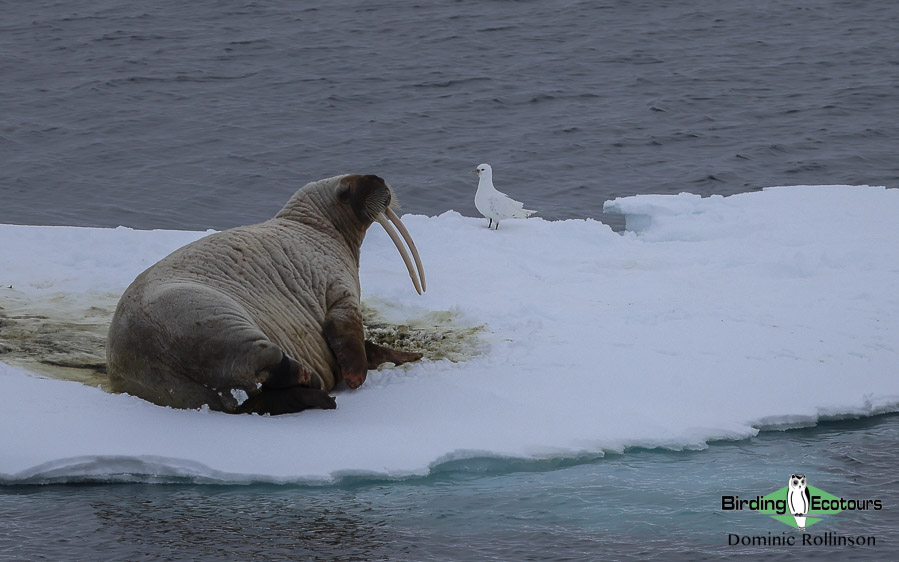
There were again large numbers of birds around all day long, with Ivory Gulls seen on and off, as well as large numbers of Thick-billed Murres, Black Guillemots, Little Auks and Atlantic Puffins seen. We even had a new trip bird in the form of a single Great Skua which flew overhead.
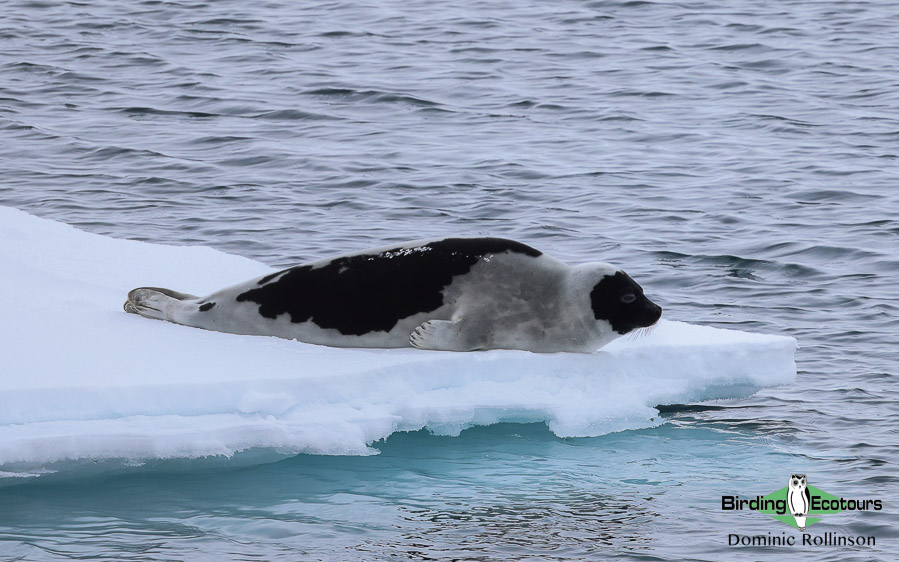
Day 7, 6th June 2023. Ytre Norskoya and Fuglelsongen
We awoke to perhaps the most beautiful morning of the trip, with blue skies and windless conditions, and boarded the zodiacs for a landing on Ytre Norskoya (ytre meaning island in Norwegian). We enjoyed a good walk through the thick snow and saw both Barnacle and Pink-footed Geese for the first time in a few days. There were also several pairs of Snow Buntings around which kept us entertained, however the highlight of the morning, and probably our most unexpected tick of the trip, was a male Western Yellow Wagtail (of the Scandanavian thunbergi subspecies) which showed briefly for us and seemed very out of place here. Western Yellow Wagtails are rare vagrants to the Svalbard Archipelago with just a few previous records.
Our afternoon’s activities involved a landing at Fuglelsongen (meaning bird song), which was alive with the sounds of singing Little Auks, and we enjoyed watching and photographing these little alcids as they went about looking for suitable mates, and we even saw some pairs mating. After watching the auks, we went for a zodiac cruise around the fjord, and although it was a little quiet, we did enjoy close views of a confiding Atlantic Puffin, a pair of Parasitic Jaegers harassing a Black-legged Kittiwake, and a Harbour Seal on the ice. That evening during dinner we glanced out of the window and spotted a few Walruses out swimming, which is always a sight to see while enjoying dinner.
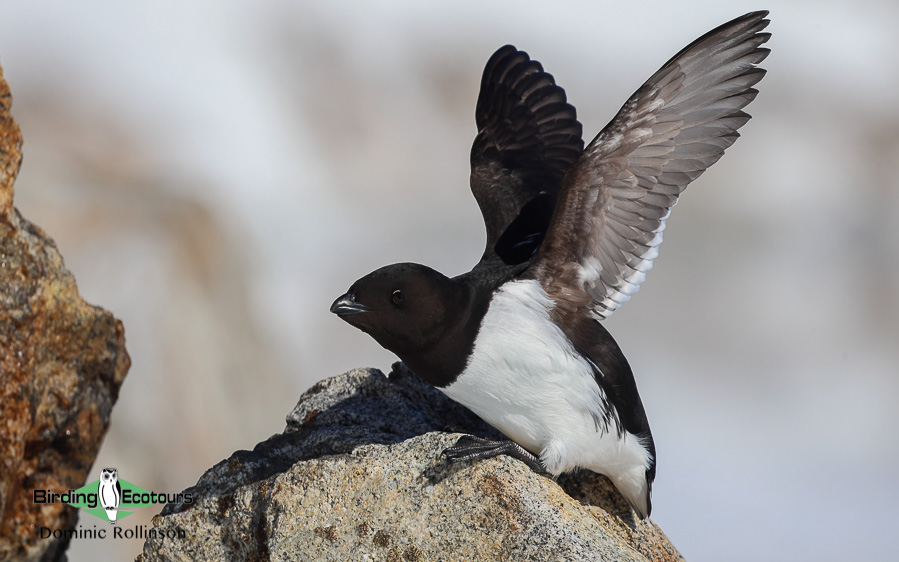
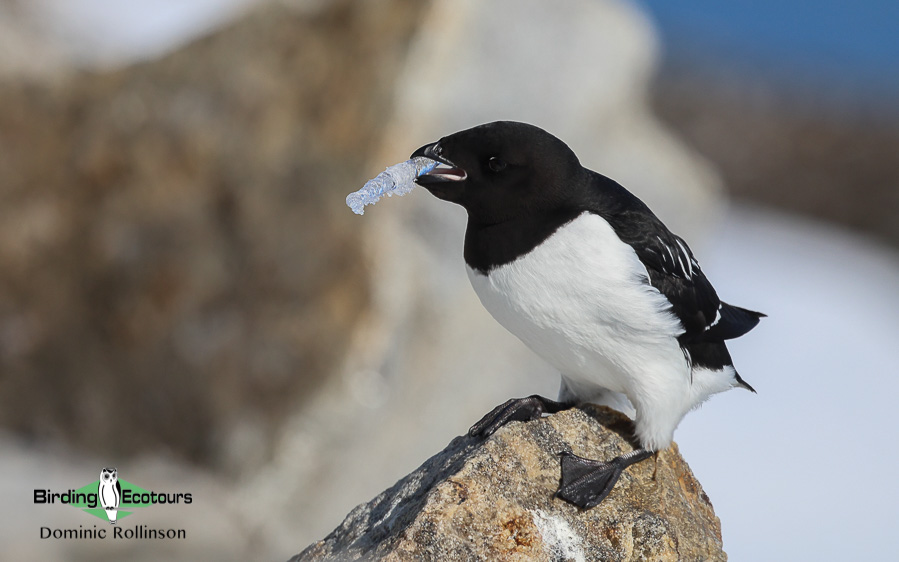
Day 8, 7th June 2023. Tordenskjoldbukta and Alkhornet
The weather was yet again on our side this morning and after breakfast we headed out on zodiacs for our landing at Tordenskjoldbukta. This morning’s landing mostly involved a gentle walk across the tundra and was very birdy and most enjoyable. The large open pebble beach had both Purple Sandpipers and Common Ringed Plovers as we landed, and we soon spotted a single Great Black-backed Gull in amongst the many Glaucous Gulls. We watched a small group of Arctic Terns as they fed in the bay and then had a Great Skua flying overhead. On our walk we enjoyed watching the many Reindeer out on the tundra and found a few shed sets of antlers. A final scan out over the pebble beach revealed a small group of Brant Geese as well as three Red Phalaropes bobbing around on the edge of the shore. As we were boarding our zodiac to head back to the ship, we spotted a beautiful breeding plumage Sanderling, which was our first sighting of the trip.
Our final afternoon of the cruise involved a landing at the impressive Alkhornet, which is a 428-meter-high mountain with huge numbers of breeding seabirds high up on the cliffs above. We enjoyed watching and listening to the masses of Black-legged Kittiwakes and Thick-billed Murres as they came and went, and even watched some marauding Glaucous Gulls as they brutally picked off a couple kittiwakes which had wandered away from the safety of the flock. There were also good numbers of Snow Buntings around, which posed nicely for photos. It was a perfectly still afternoon with gorgeous views out over the surrounding fjords and, before we headed back to our ship, we watched as a few brave souls took a polar plunge in the icy waters.

Day 9, 8th June 2023. Departure from Longyearbyen
After a fantastic and highly successful week-long Arctic cruise, we headed back into Longyearbyen before our early afternoon flights back home. We had some time to kill before our flights and took a walk around town where we enjoyed further looks at Parasitic Jaeger, Common Eider, Purple Sandpiper and Snow Bunting. Thank you, Karen and Wendy, for all the good laughs and fun memories.
Bird List – Following IOC (12.3)
The following notation after species names is used to show conservation status following BirdLife International: VU = Vulnerable.
|
Common Name |
Scientific Name |
|
Ducks, Geese, Swans (Anatidae) |
|
|
Brant Goose |
Branta bernicla |
|
Barnacle Goose |
Branta leucopsis |
|
Pink-footed Goose |
Anser brachyrhynchus |
|
King Eider |
Somateria spectabilis |
|
Common Eider |
Somateria mollissima |
|
Tufted Duck |
Aythya fuligula |
|
Long-tailed Duck – VU |
Clangula hyemalis |
|
|
|
|
Pheasants & Allies (Phasianidae) |
|
|
Rock Ptarmigan |
Lagopus muta |
|
|
|
|
Plovers (Charadriidae) |
|
|
Common Ringed Plover |
Charadrius hiaticula |
|
|
|
|
Sandpipers, Snipes (Scolopacidae) |
|
|
Ruddy Turnstone |
Arenaria interpres |
|
Purple Sandpiper |
Calidris maritima |
|
Dunlin |
Calidris alpina |
|
Sanderling |
Calidris alba |
|
Red Phalarope |
Phalaropus fulicarius |
|
Red-necked Phalarope |
Phalaropus lobatus |
|
|
|
|
Gulls, Terns, Skimmers (Laridae) |
|
|
Black-legged Kittiwake – VU |
Rissa tridactyla |
|
Ivory Gull |
Pagophila eburnea |
|
Great Black-backed Gull |
Larus marinus |
|
Glaucous Gull |
Larus hyperboreus |
|
Iceland Gull |
Larus glaucoides |
|
Arctic Tern |
Sterna paradisaea |
|
|
|
|
Skuas (Stercorariidae) |
|
|
Great Skua |
Stercorarius skua |
|
Parasitic Jaeger |
Stercorarius parasiticus |
|
|
|
|
Auks (Alcidae) |
|
|
Little Auk |
Alle alle |
|
Thick-billed Murre |
Uria lomvia |
|
Black Guillemot |
Cepphus grylle |
|
Atlantic Puffin – VU |
Fratercula arctica |
|
|
|
|
Loons (Gaviidae) |
|
|
Red-throated Loon |
Gavia stellata |
|
|
|
|
Petrels, Shearwaters, Diving Petrels (Procellariidae) |
|
|
Northern Fulmar |
Fulmarus glacialis |
|
|
|
|
Wagtails, Pipits (Motacillidae) |
|
|
Western Yellow Wagtail |
Motacilla flava |
|
|
|
|
Longspurs, Snow Buntings (Calcariidae) |
|
|
Snow Bunting |
Plectrophenax nivalis |
|
Species Seen |
31 |
Mammal List
The following notation after species names is used to show conservation status following IUCN Red List: EN = Endangered, VU = Vulnerable.
|
Common Name |
Scientific Name |
|
|
|
|
Rorquals (Balaenopteridae) |
|
|
Common Minke Whale |
Balaenoptera acutorostrata |
|
Blue Whale – EN |
Balaenoptera musculus |
|
|
|
|
Dog-like mammals (Canidae) |
|
|
Arctic Fox |
Vulpes lagopus |
|
|
|
|
Walruses (Odobenidae) |
|
|
Walrus – VU |
Odobenus rosmarus |
|
|
|
|
True seals (Phocidae) |
|
|
Bearded Seal |
Erignathus barbatus |
|
Harp Seal |
Pagophilus groenlandicus |
|
Ringed Seal |
Pusa hispida |
|
Harbor Seal |
Phoca vitulina |
|
|
|
|
Deer (Cervidae) |
|
|
(Svalbard) Reindeer (Caribou) – VU |
Rangifur tarandus platyrhynchus |
|
Species Seen |
10 |
DOWNLOAD TRIP REPORT
This is a sample trip report. Please email us ([email protected]) for more trip reports from this destination.
Svalbard (Spitsbergen) Cruise: Polar Bears and Seabirds
Tour-specific Information
TOUR OUTLINE
This Arctic wildlife and birding cruise around the Svalbard Archipelago (part of Norway) offers perhaps the best chance of seeing some of the Arctic’s most iconic wildlife and birds. The cruise leaves from Longyearbyen (Svalbard’s largest town and one of the most northerly settlements in the world) and returns eight days later. We often suggest a full extra day’s birding (before or after the cruise) around Longyearbyen where a few particular species can be seen at closer range, such as Rock Ptarmigan and Arctic Fox. Most cruises head along the coastline of the largest island of the archipelago, Spitsbergen and when possible, a day will be spent in the pack ice.
The highlight and biggest target of any Arctic cruise is Polar Bear and on this trip we stand an excellent chance of seeing ‘the King of the Arctic’ alongside other charismatic wildlife such as Beluga, Walrus, Bearded Seal, Arctic Fox, Reindeer and an assortment of other seal and cetacean species, including the possibility of Blue Whale. Of course, it is not only the amazing mammals which attract tourists to the Arctic. On this cruise we also stand a good chance of seeing a true high-Arctic species, Ivory Gull (often hanging about Polar Bear kills). Other fantastic bird species including King Eider, Long-tailed Duck, Rock Ptarmigan, Red Phalarope, Purple Sandpiper, Long-tailed Jaeger, an assortment of alcid species and many others are likely. Wildlife aside, this cruise offers fantastic scenery as we head through beautiful fjords and view impressive glaciers. We invite you to join us as we take in the best that the Arctic has to offer!
DAILY ACTIVITIES, PHYSICAL REQUIREMENTS, AND TOUR PACE
On most days during the cruise, we will undertake two landings and have two zodiac cruises (zodiac boats are small inflatable boats which take around 10-12 passengers). During our day (or two) in the pack ice we will be entirely ship-based, when we spend our time looking for Polar Bear and Ivory Gull. The landings can occasionally be a bit rough (depending on sea and ice conditions) and may sometimes involve walking over slippery rocks or ice to and from the zodiac boat. If the landing looks too rough, there is always the option to stay onboard the ship, or to just join for the zodiac cruise (often through beautiful fjords) and return to the ship after the zodiac cruise.
During the landings we normally spend a couple hours wandering around the area, enjoying the wildlife and plants of the Arctic. These short walks, normally up to half a mile (one kilometer), are normally at a very gentle pace, allowing you to enjoy the wildlife and scenery at leisure. It is very important to remember that during these landings Polar Bears are a possibility and are a danger. However, there will always be armed guides around during these landings and the areas are always thoroughly scouted beforehand to ensure we have no encounters with Polar Bears. As such we must always adhere to the instructions of the guides and not wander beyond the demarcated area.
A rough breakdown of a typical cruise day is as follows: 07h30-08h30: breakfast, 09h00-11h30: landing/zodiac cruise, 12h30-13h30: lunch, 14h30-18h00: landing/zodiac cruise, 18h30: daily recap, 19h00: dinner. As mentioned above, you do not have to join the zodiac cruises or landings, should you prefer to stay on the ship.
Although the sea conditions are generally quite flat, it may, on occasion, get a little choppy out at sea and we recommend bringing sea sickness medication (consulting your doctor, beforehand), if you are prone to sea-sickness.
SAFETY
This cruise is considered very safe and safety should not be a concern when signing up. Polar Bear encounters are possible during our landings, however all precautions are taken to ensure this does not ever happen. If a Polar Bear is seen in the area (we’re hoping this happens for us) then we will not land at that site but may perhaps get closer on zodiac boats. Whenever we make a landing there will always be armed guides around who are trained in what to do should a Polar Bear show up!
Getting in and out of boats can, at times, be tricky. Sometimes we step off the zodiac boats onto slippery rocks or ice. There will always be a helping hand around to aid you as you climb into and out of the zodiac boats. Walking sticks may aid you on some of the tricker landings/walks. Should you prefer to skip any landings and rather stay on the ship, this is always possible.
WEATHER/CLIMATE
Being an Arctic cruise, you should expect very cold weather conditions. However, our cruises take place in mid-summer and thus temperatures are generally not too extreme. Average temperatures in June and July (when our cruises depart) are around 36–48 oF (2–9 oC) but it will often drop below freezing. Precipitation, in the form of rain, sleet or snow is always possible and thus it is important to bring along an entirely waterproof ‘outer shell’ (trousers and a jacket). Any form of precipitation, or sea spray, together with a strong, biting wind can make it feel significantly colder and thus it is vital to dress adequately, especially on the zodiac cruises/landings. On some days the weather can be lovely and mild and, on these days, it is important to ensure you bring sunscreen along. The climate inside the ship is well maintained and always comfortable and so should things ever get too cold or wet out on deck, you can return to the warmth and comfort of indoors and watch wildlife from lounges etc.
ACCOMMODATION
The accommodation onboard the cruise ship is of a high standard and is very comfortable. Depending on your preference (and budget) it is possible to book a berth in a 4-sleeper cabin, 3-sleeper cabin, 2-sleeper cabin or to have a cabin to yourself. The entire range of accommodation options has plenty of cupboard and drawer space to unpack your bag for the week and there are multiple charging points in all the cabins.
We will be visiting the Arctic during the mid-summer which means 24 hours of daylight, despite this, sleeping is not normally an issue as all cabins have blackout curtains/blinds.
DOMESTIC FLIGHTS AND ACCOMMODATION IN LONGYEARBYEN
Once you have finalized your booking with us, we would recommend booking your domestic flight (from Oslo or Tromsø) as soon as possible, as flights get booked up very early during the busy summer season. This also applies to accommodation in Longyearbyen which also books up very early.
The cruise generally leaves late in the afternoon/evening and so it is possible to fly in on the same day as your cruise departure however we would strongly advise to arrive at least one day before your cruise departure. This is because there seem to be routine luggage issues from flights from Oslo, with luggage sometimes only arriving the day after your flight. An extra night or two in Longyearbyen is not a bad idea, with there being plenty of wildlife and birds to see and other activities which will easily keep you entertained. On one of these days, you could join us on a guided tour around the area, targeting a few species which are not always seen as close-by on the cruise (Rock Ptarmigan, Arctic Fox, etc)
Upon arrival at Longyearbyen airport, you can easily take the bus which stops at all the accommodation establishments and simply pay for this by credit card once you get onboard. Be sure to let the bus driver know which accommodation you are staying at though.
CURRENCY AND MONEY
For your time around Longyearbyen (before or after the cruises) it is possible to use Norwegian Krone (NOK), however everybody accepts and prefers to use credit cards. If you will only be on Svalbard (and not on the Norwegian mainland) it is actually suggested to not bother organizing cash, as all establishments (from taxi drivers, to vendors to restaurants) accept credit card, with some establishments not accepting cash at all! Longyearbyen is essentially a cashless society, with no ATMs existing on the archipelago.
While onboard the cruise ship, any extra expenses will be added to your bill which is to be settled at the end of the cruise, either by credit card, or cash (US dollars or euros). Credit card is again the preferred method of payment here. In fact, the only thing you would exclusively need cash for would be for gratuities.
ELECTRICITY
In Norway (including Svalbard) the power plugs and sockets are of Type F. The standard voltage is 230 volts (V), and the standard frequency is 50 hertz (Hz). Further details and photos of this plug can be found here.
Adaptors and voltage converters are likely to be needed for some visitors from overseas (e.g. if you are from the United States) — please be cautious with certain appliances that utilize different frequencies. You can use your electric appliances in Norway, if the standard voltage in your country is in between 220–240 V (such as the UK, Europe, Australia, and most of Asia and Africa). If the standard voltage in your country is in the range of 100–127 V (as is in the USA, Canada, and most South American countries), you will need a voltage converter in Norway, but please visit this website for specific details.
COMMUNICATION
In Longyearbyen, it is possible to buy a local SIM card which can be used around town, while on the ship cellphone/mobile connection is very limited and should not be relied upon. It is possible to buy data for Wi-Fi onboard the ship however the data packages are generally very expensive and we would suggest simply going offline for the week. For those who need to stay connected you can buy these data packages once onboard. Some ships offer small complimentary data packages.
MEALS
The food onboard is of an excellent quality, with a wide array of options to suite everyone’s requirements or taste. Breakfasts and lunches are generally a buffet with many options available, with dinners generally being a la carte, with meat, seafood and vegetarian options all available. Water and juice are provided free of charge with meals however any soft drinks or alcoholic beverages will be for your own account. The tap water onboard the ship is safe to drink and so we would recommend bringing along a water bottle which can be refilled, to take with you on landings and zodiac cruises.
WHAT TO BRING: CLOTHING AND OTHER ITEMS
If you plan to join any of the landings or zodiac cruises (highly recommended) it is mandatory to bring along a waterproof ‘outer shell’ which essentially means you must bring along waterproof trousers and a waterproof top (a jacket/poncho). With temperatures potentially getting below freezing (with the added effect of wind chill), it is important to bring along adequate clothing, with many clothing layers being the name of the game in the Arctic.
For those people who are a little unsteady on their feet, a walking/hiking pole will be a good idea.
Before our first landing, we will all be provided with strong, warm and waterproof Muck boots which are to be worn for all zodiac cruises and landings. The boots are supplied in a variety of sizes onboard and you are sure to be able to find a size that fits you well. For normal life onboard the ship, a comfortable pair of sneakers/trainers will be just fine. Sandals or slops are not recommended.
Although most wildlife and birds are very approachable and are often unphased by the presence of humans, which means you can get close to most wildlife, a telescope is recommended. Some animals, such as Polar Bears, are not allowed to be approached by large ships (beyond a certain buffer zone) and so a telescope will help here. Similarly, some of the seals in the pack ice are often only seen at distance and so a telescope will help aid identification. Our guide will ensure a telescope is taken along, for those who do not have a telescope or do not want to bring one along.
Download Svalbard (Spitsbergen) Cruise: Polar Bears and Seabirds Information
‘I don’t think we could have had a better time or been more pleased with Dominic Rollinson on our Oceanwide Arctic Cruise this past June. We had a wonderful time touring in South Africa with Dom last year and were eagerly anticipating this trip and Dom did not disappoint!
Dom is the consummate birding guide. He has an absolute command of where the birds are, how they behave, actually finding them, and getting us great looks of them! Dom is very organized and timely with his pre and post trip communications, which was very helpful. Dom shared the trip eBird lists, the well-written and illustrated trip report, and beautiful pictures in a timely fashion. And Dom is just a true gentleman and an absolute pleasure to be with. He is kind, considerate, easygoing, thoughtful, and has a great sense of humor.
Dom was very proactive in coming up with ways to make our arctic experience great! He suggested that we rent a vehicle for our pre-cruise time in Longyearbyen, which was a fantastic idea. And Dom maximized the vehicle rental by taking us out both the evening and morning before we boarded our cruise and we got fantastic close views of all our targets – in particular, absolutely gorgeous views of the Red Phalarope and the Arctic Fox! It was also a very relaxed way to see some local sights including the Global Seed Vault and the northernmost church in the world. Dom also spent the morning after disembarkation with us birding around Longyearbyen on foot, which was such a treat. He was very generous with his time.
We have so many great memories of Dom on the cruise ship! We felt very privileged to have Dom’s expertise available to us and we also appreciated that he graciously shared that expertise with other passengers. Dom was always cheerful and helpful whether we were on excursions, on deck looking for whatever wildlife presented itself, or whatever else we might have gotten ourselves into. I know that the ship’s guides also really appreciated Dom. I heard one of them tell another that they should always listen when Dom was talking because “You can learn so much from Dom!” We all are grateful for the huge amount of time Dom spent on deck scanning for polar bears and other wildlife, no matter what the temperature or wind conditions!
We highly recommend Dom. If you are considering a trip that Dom is leading, I would encourage you to sign up immediately – you won’t find a better guide!’
Karen and Wendy
‘When we were out away from the day to day living, this expedition brought the peace and quiet that was much appreciated. I enjoyed this being an informational expedition on a small ship and not a cruise of 1000’s of cruisers. The knowledgeable and friendly staff shared unknown information to me about the environment and the mammals and birds.’
Janis
